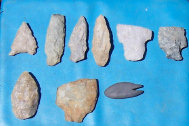
Archaeologists retained by the Warwick Sewer Authority have been unearthing a variety of artifacts in test trenches for more than three years and recently issued a report stating that the Mill Cove area was probably home to generations of Native Americans, with artifacts from about 3,000 years ago through the 1600s.
Given those findings and the need for far more extensive archaeological study before any sewer construction could begin, the WSA is exploring less-disruptive engineering methods while other city officials say that sewers may be out of the question for the neighborhoods just north of Warwick Neck.
"I'm committed to trying to find a way," WSA Director Janine Burke said. "There are people out there who need sewers and who want sewers."
She noted that the city and the WSA recognize the importance of the artifacts and are staying in contact with the federal Environmental Protection Agency as it negotiates with the Narragansett Indians about the historical significance of the area and what construction work could be done there. According to reports from Alan Leveillee of Public Archaeology Laboratory Inc., test trenches have revealed ceramic chards, tools, human bone fragments, pot molds and more.
John Brown, historical preservation officer for the Narragansett Indians, said that the cove and adjacent coastal land around Old Mill Brook was clearly a significant site in Native American history. The artifacts indicate that the area was settled by Native Americans long before Europeans landed on the New England shore, he said, and that the area probably had multiple uses - - including shellfishing, agriculture, living areas and ceremonial grounds.
"This has been an ongoing issue for the past several years," Brown said, emphasizing that while the Narragansetts are committed to preserving their heritage, they are also sensitive that there are health and environmental issues involved with the sewer project. "We're working cooperatively with everyone involved," he said.
The Neighborhoods off Tidewater Drive are among several that are slated for sewers as the WSA continues the daunting task of trying to expand the sewer system in a densely populated city where most homes were built with either cesspools or septic systems.
About 70 percent of the city has sewer mains, Burke estimated, but not everyone has opted to tie into sewers where they are available. Resident of some areas, such as the Governor Francis neighborhood, are protesting - objecting not only to the cost of the assessment they must pay for having a sewer line at their property, but also to the prospect of abandoning costly septic systems that they say are still working fine.
It's a different story around the Mill Cove area, she said, because many of the houses have cesspools that will be subject to mandatory replacement under a state law that requires that they be replaced under specific circumstances, including proximity to coastal areas. She said that the WSA is looking at different engineering methods that might enable the agency to run the lines below the archaeologically sensitive areas.
She said the WSA is also working with Councilman John DelGiudice, who represents the area.
DelGiudice said that, given what's been found and that the amount of land involved has not been determined, it is time to look for ways to help residents who might be forced to replace their cesspools.
DelGiudice and Councilman Stephen Colantuono arranged a recent meeting with Warwick's congressional representatives in the hope that some funding could be found to assist residents if they have to replace their cesspools and do not have public sewers as an option.
"The Native American findings are so significant that this project could be held up for five years or more," DelGiudice said, adding that he is hopeful that the city and sewer authority can set up a program that would partially pay for residents' new septic systems and offer them low-interest loans for the remainder.
He said a new septic system can cost $10,000 or more, and "I believe that a fair amount of people will be affected and are going to need some assistance."



Reader Comments
to our Newsletter